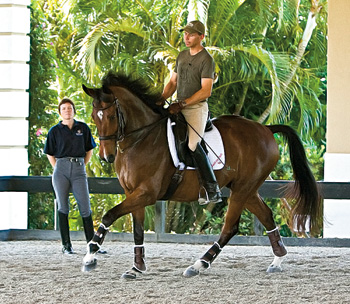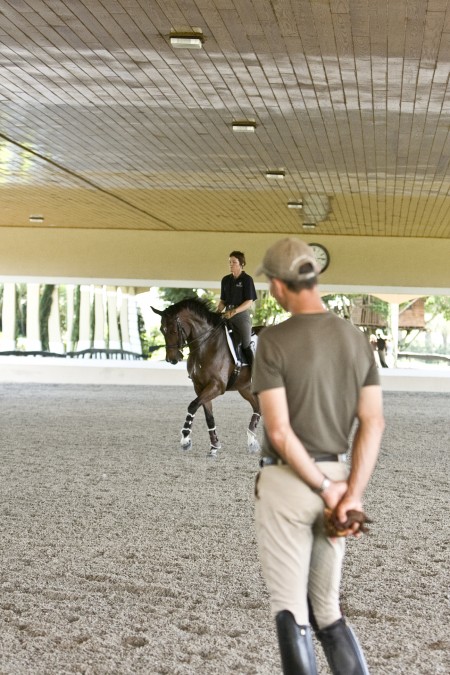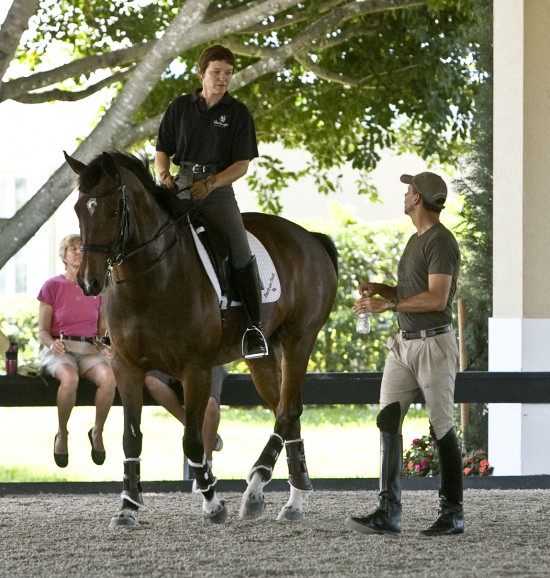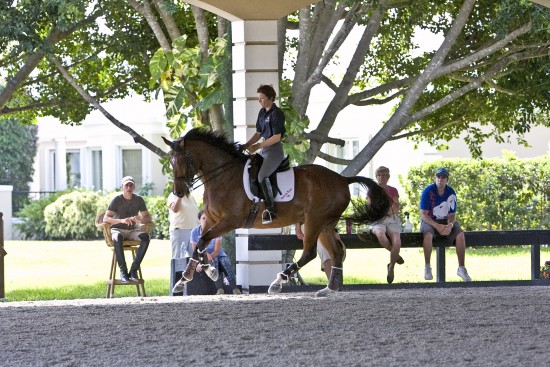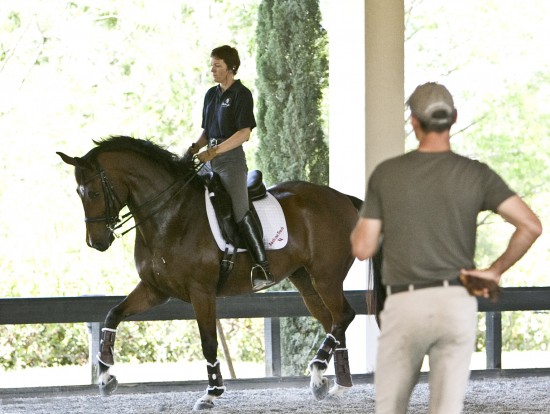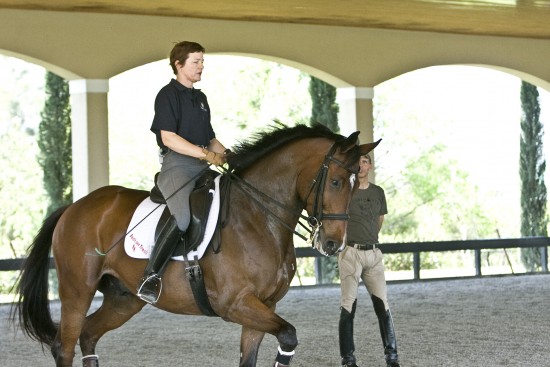Then we take a walk break. The lessons all have this total attention to detail.
The walk break is rarely just that. It is a chance to discuss the next stage of the lesson, to talk about any issues or to school the walk! “Extended walk, all they want to see is that the neck stays parallel to the ground, not necessarily lower, the nose slightly in front of the vertical. It is so important for him that when you fire him up in trot and canter that this (the walk) still works.”
Steffen uses the whip in a very specific manner, he carries it so it can bounce over the croup. It is not a tool for reprimand, it is used to get the attention of the horse and to ask for more activity of the hindlegs or lowering of the croup. Cadenza likes to duck his head slightly here and there, losing the steadiness of the frame in the process. It is only small and many people wouldn’t comment on it at all. Not Steffen.
“When he takes that little step with his nose there, a little tap with the whip, within a tenth of second, repeat this every time.” Sure enough Cadenza lowers and activates behind and the carriage becomes progressively steadier.
We go back to canter and assess where we are after the break.
“All the time checking the forwards response to the aid. Develop it forward and collection, straightness, OK, and half pirouette on the diagonal.”
I ride an OK pirouette, but let Cadenza start the pirouette a little away from where I had originally intended.
“Try to start from the line you choose. OK. Careful, you missed the line at the end, when you are done with the pirouette try to leave on the line you are on, don’t go back to your original line. Also, with the pirouette you started big and then made it small in the second quarter, do it the other way, the first quarter small, the second quarter big. Later on for the full pirouette it is the exact same idea, there can always be a stride in the middle where you make it a little bit bigger.”
We repeat and the results are much improved so we move on to some more work in the canter…
“And some changes, you decide when it is ready, first on the long side, the quarter line.”
I do the first change. It is good and, then, as I prepare for the next, he falls into my left leg.
Steffen is as quick to see it as I am to feel it. ”Waiting, waiting, make sure after each change it is possible to get some leg yielding or shoulder-fore in there. This needs to be possible, that you can move him off the leg anytime, either side between the changes.”
Cadenza and I quietly discuss his desire to use my left leg as a leaning post (it’s not the first time), he quickly starts a lovely leg yield from it, then a little positioning and I finish a couple more changes before doing a nice straight series of four tempis and then threes on the diagonal.
In the lesson, Steffen never pressures you to get started. So although it takes me half the diagonal to have him really 100% on the aids and straight, the three tempis are uphill, straight and beautifully in the rhythm of the canter, three good three tempis.
“No more. Finish with them like this, transition to trot and then we give him a little break.”
This is followed with a quick summation of what he has seen through the ride, given he knows the horse and myself pretty well at this stage.
“That was good Ilse, you are much more on top of it, he is always going to be a little on the tricky side, but you are right there and it doesn’t take a strong correction any more, just a quick reaction. Yes, quite good.”
“OK on the next short side collected walk then at S pick up the trot, then some half steps and a little passage at the end. I pick up the reins and prepare to trot.
“Quick. He needed a little tap there. Did you feel it?” I confess I felt something tiny and didn’t react to it. “Whenever he goes against the bit, or opens his mouth, deal with it, just a little tap.” I prepare to go back into trot.
“Keep him uphill before the transition, think forward passage.” He gets tight in the back and wiggly so I go into rising trot.
“Lots of good decisions here, when you have made the correction then relax your shoulders and forward again and then only just a few steps of passage.
“Simply feel what’s going on in front and if he takes a little too much (in the bridle) then very quickly getting to the hindlegs with a light tap of the whip, really stay on top of it.” We move from passage to piaffe.
In piaffe: “Let the tempo settle a bit, give him a chance to find the rhythm, I know he has to be in front of the leg but let him settle into the rhythm, if he walks then go ahead and help him. Otherwise don’t help him with the leg.
“You can keep your leg near him, heels down and piaffe, and out of it and back to piaffe. When you have your legs near him and you ride with gentle pressure, just because of the motion of his back your legs will ride him with a two-beat rhythm, you don’t need to create it with your seat or a left /right rhythm of the leg or the spur. At this stage you may need to help create the rhythm with light taps of the whip.”
“Now I would expect that when I close the leg and cluck a bit that he is right there.”
We flow into a completely on-the-aids piaffe with good rhythm right when I ask for it.
”Well done. Really nice.”
On that positive note we finish, letting him stretch – still controlling the tempo and the frame. Next clinic is 2 months away…I can’t wait!

